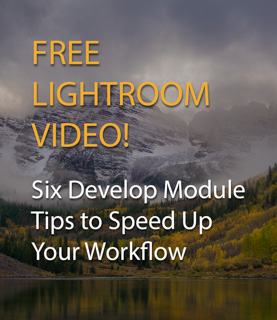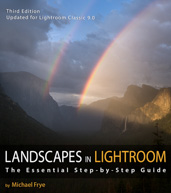Vision and Creativity
by Michael Frye | Jul 2, 2013 | Light and Weather, Vision and Creativity, Workshops
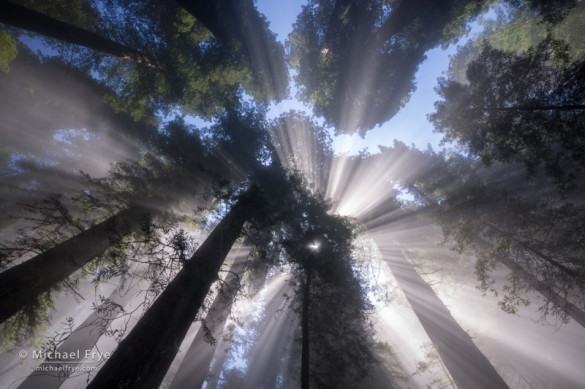
Sunbeams through the redwood canopy, Del Norte Coast Redwoods SP, CA, USA
Weather always plays a big role in landscape photography. I study the weather so that I can put myself – and my workshop students – in the right place at the right time. But a little luck always helps.
During my recent workshops up in the redwood country we found some wonderful juxtapositions of fog and sunlight. One morning, during the second week, we pulled up to a trailhead and everyone immediately got out their cameras because we saw beautiful godbeams right from the parking area. But, as it turns out, we didn’t need to rush. Usually these sun-breaking-through fog moments are fleeting, but it turns out that we were right at the top of a relatively stable fog bank, so the mixture of sun and fog lasted for hours along parts of the trail. The photograph above is just one of many sunbeam photographs I made that morning, and everyone in the group came away with some great images from that day.
(more…)
by Michael Frye | May 24, 2013 | Vision and Creativity
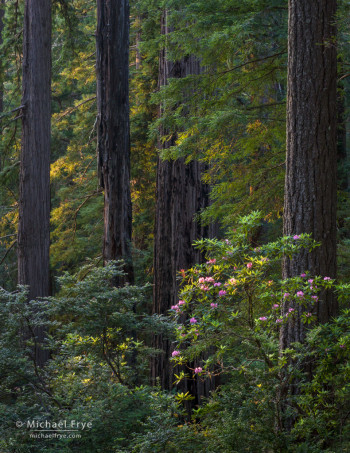
Redwoods and rhododendron, late afternoon
I’m up along the far northern California coast, scouting for my upcoming redwood workshops. I just love this area, and I’m having fun exploring some new locations, as well as reacquainting myself with old favorites.
We’ve had off-and-on showers, with periods of soft light broken up by sunshine and interesting clouds. On Tuesday afternoon a rain squall passed through, and then skies cleared late in the afternoon – perfect conditions for photographing some of the sea stacks that are so abundant along the coast here. I’ve included three images from that afternoon below.
I found a redwood grove that gets sunlight very late in the afternoon, and watched beautiful amber light streaming through the forest as I walked along the trail. Photographing a forest with patches of sun and shade is a lot like photographing a landscape with dappled light from broken clouds. The light has to highlight the most interesting parts of the scene for it to work, but when that happens the modulated, chiaroscuro lighting can add depth, dimension, and mood to the photograph. I found a couple of compositions where the light hit just the right places: the image of redwoods and rhododendrons at the top, and the one with faint sunbeams below.
(more…)
by Michael Frye | Mar 28, 2013 | Light and Weather, Vision and Creativity, Yosemite Photo Conditions
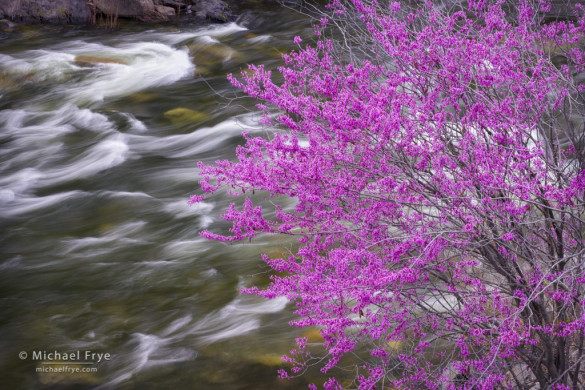
Redbud along the Merced River, Merced River Canyon, near Briceberg, CA, USA
Last weekend I visited the Merced River Canyon, looking for flowers. As I wrote last week, there are more blooms than expected, given our dry winter, but it’s still a below-average year for poppies. The redbuds, however, were in great shape last weekend. Some were starting to leaf out, while others weren’t in full bloom yet, so I’d say it was just about peak for redbuds. More will start to leaf out every day, but there should still be many beautiful redbuds this weekend and beyond.
Sunday afternoon it was very windy in the canyon. I found the scene above, with a redbud against the flowing river, and waited for half an hour for the wind to die down before giving up and walking upriver. On my way back to the car it seemed that the wind had calmed a bit, so I set up my tripod again, only to realize that it was almost as windy as before. I waited another half hour, and finally it became perfectly, completely still for about a minute, and I was able to make this photograph.
(more…)
by Michael Frye | Mar 14, 2013 | Light and Weather, Vision and Creativity
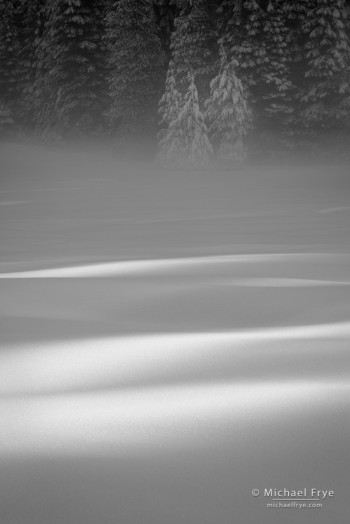
Sunlight slanting across Crane Flat Meadow, Yosemite NP, CA, USA
A Trip to Crane Flat
Yosemite got some much-needed precipitation last week – over an inch total. I kept checking the radar and satellite images online, looking for an opportunity to photograph a clearing storm. Friday morning seemed promising, so I drove up to Yosemite Valley early, but found no snow. It looked like the snow level had been around 5,000 feet, higher than forecast. Worse, from a photographic perspective, the skies were clear and there was no mist.
Shortly after sunrise I noticed light striking a ridge near the tunnels on Highway 120, and on a whim decided to drive up to Crane Flat. I thought Crane Flat would at least have some fresh snow, since it’s at 6,000 feet.
Indeed there was fresh snow – over a foot of it. I parked at the Tuolumne Grove trailhead and walked along the plowed road. The sun had just reached parts of the main meadow, and I found some interesting small subjects to photograph, like tree-shadows on the snow.
Some shafts of sunlight slanting across the snow caught my attention, and then some mist began rising near the edge of the meadow, behind the shafts of light. I immediately recognized the potential to make an image that went beyond an abstract study of shadows – a photograph that had a mood.
(more…)
by Michael Frye | Jan 23, 2013 | Composition, Vision and Creativity
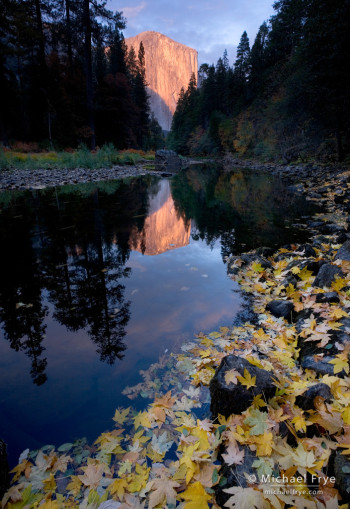
El Capitan and the Merced River, autumn, Yosemite NP, CA, USA
Depth can be a powerful tool in photography. Our medium is two-dimensional, but a sense of depth, an illusion of space and distance, can make the viewer feel like part of the scene, and literally and figuratively add another dimension to a photograph.
A Common Formula
This image of El Capitan follows a common formula for creating a three-dimensional effect in landscape photographs: find an interesting foreground (preferably with some leading lines), get the camera low and close to that foreground, and use a wide-angle lens.
A wide-angle lens by itself can’t create a sense of depth. Wide-angle lenses make things look smaller, and therefore more distant, but if everything looks small and distant there’s no sense of depth. The 3-D effect only happens when you put the wide-angle lens close to something in the foreground. That proximity makes the foreground look big, but things in the background still look small. The optics create an exaggerated size difference between near and far objects, and our brains interpret that as depth and distance.
This wide-angle, near-far look is common today, but it wasn’t always so. Though he wasn’t the first to use this perspective, master landscape photographer David Muench popularized this technique through his many beautiful books, and a lot of people have followed his lead.
But this look has become so popular that I think landscape photographers have stopped looking for other ways to create a sense of depth, and by doing that we’ve limited our options. We owe it to ourselves and our viewers to explore other paths, and create images with depth and meaning that go beyond this one formula.
(more…)
by Michael Frye | Oct 24, 2012 | Vision and Creativity, Yosemite Photo Conditions
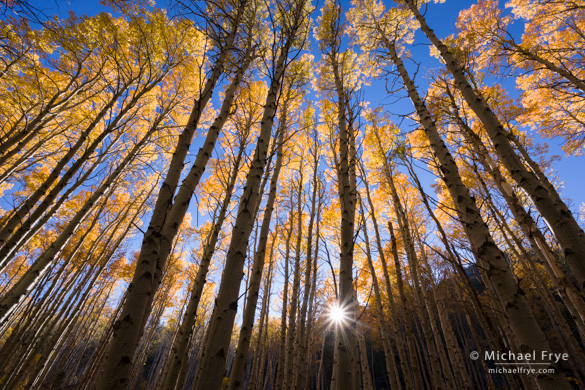
Backlit aspens, Saturday afternoon
Mike Osborne and I just completed our Eastern Sierra Fall Color workshop this past weekend. It was a lot of fun—wonderful people, beautiful weather, and lots of color.
The focus of this workshop was composition and creativity, and it was great to see the participants growing and learning during the class. I saw a lot of beautiful compositions and imaginative ideas on the back of people’s cameras and in the evening image-review sessions.
One of the things we talked about during this class was the creative process. This process varies from one person to another, of course, and can also change depending on the situation and subject. Sometimes—especially with my nighttime work—I plan out every detail in advance. At other times—particularly if I’m in what Mike calls a “target-rich environment,” with interesting subjects and light—then I tend to work quickly, reacting to the changing light and photographing whatever catches my eye at that moment.
The accompanying photographs show a small demonstration of that “reactive” process in an aspen grove on Saturday afternoon. When we first arrived at this spot the trees were in the sun, and the backlit orange leaves against the blue sky were a striking sight. We all tried different compositions—looking up, looking into the sun, using both wide-angle and telephoto lenses. Of my own images, I ended up liking the wide-angle frame at the top of this post the best, with the sun about to dip behind the background ridge.
(more…)







